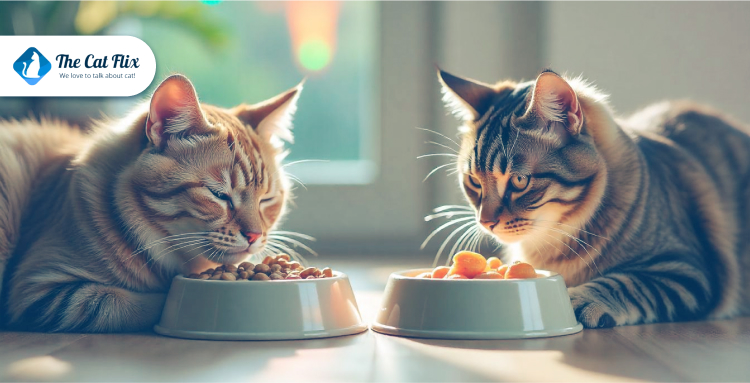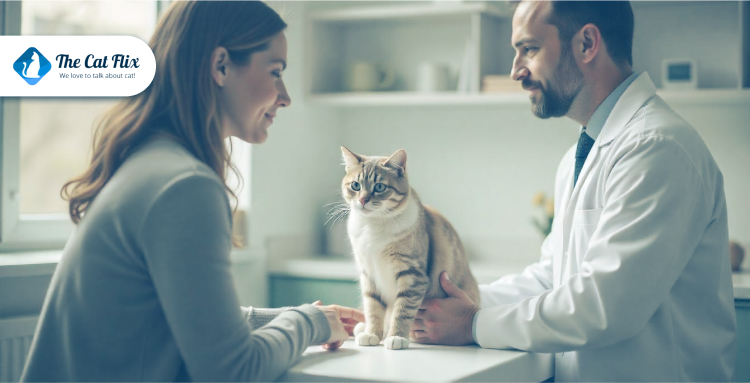See, loving a cat isn’t the same as understanding one. We feed them, cuddle them (when allowed), share videos of them knocking glasses off countertops like furry little rebels… but behind that casual companionship lies a world of needs we sometimes miss. Not because we don’t care, but because we assume they’ve got it all figured out. They’re independent, right?
But what if some of the things we do are actually stressing them out? What if our well-meaning habits are quietly eroding the trust we’ve built? That soft purr? It might be covering up a long list of unspoken needs.
So before you give yourself a gold star for being the “cool cat parent,” let’s press pause. Let’s look at the little things—the overlooked, the accidental, the mistaken.
1) Training? For Cats? Yes, And They’ll Thank You for It (Eventually)
Ah, the old myth that cats cannot be trained. As if they’re too refined, too aloof, too busy being mysterious to bother with your silly little commands. However, cats aren’t untrainable… they’re just misunderstood.
Unlike dogs, cats won’t jump through hoops to please you but they’ll absolutely learn if what you’re offering benefits them. Want to stop the midnight sprints across the piano keys? Tired of finding “gifts” outside the litter box? Training is about harmony, not dominance. It’s a shared language built on patience, timing, and the occasional very fancy treat.
“Only 4% of cat owners have attempted any formal training with their cat.”
Source —ASPCA, 2022 Pet Owner Survey
That number? Too low. Because training isn’t limited to tricks. It’s also about gentle behavior shaping like redirecting scratching from your favorite chair to a sisal post before it becomes a habit. Or teaching them that counters aren’t jungle gyms. Or—yes—even coaxing shy rescues out of their shells with clickers and consistency.
Even litter training can go deeper than “here’s a box.” Some cats require more than instinct; they require encouragement, proper placement, and litter that does not smell like chemical warfare. And when we assume “they’ll figure it out,” we risk missing early signs of stress or discomfort.
2) Declawing Is a Trauma, Not a Trim

Declawing isn’t a cosmetic fix. It’s not a nail trim. It’s a surgical amputation, removing not just the claw but the entire last bone of each toe. Imagine losing your fingertips at the last joint just to stop tapping the table. That’s the scale of what’s taken from a cat.
“Declawing is prohibited in over 20 countries, as well as in cities such as Los Angeles, San Francisco, and Denver in the United States, due to the severe pain, long-term complications, and ethical concerns.”
Source —Paw Project & Humane Society
It doesn’t stop there. Declawed cats often shift their weight unnaturally, leading to chronic pain in their spine and joints. Some develop aggression or stop using the litter box entirely—because even walking on certain surfaces hurts. What starts as a solution to one problem often births a whole series of new ones, ones that fracture the fragile trust between human and cat.
Dr. Jennifer Conrad, veterinarian and founder of the Paw Project, puts it simply:
“Declawing does not protect cats—it damages them, physically and emotionally. It’s a procedure of convenience, not necessity.”
However, there are kinder ways. Nail caps, for example are easy to apply and completely painless. Regular trimming, paired with well-placed scratching posts (hint: near where they already like to scratch), works wonders. And let’s not forget cardboard ramps, sisal towers, or even cat trees dressed in textures they love to sink their claws into.
Your cat isn’t clawing to ruin your furniture—they’re stretching, marking territory, filing nails, expressing instinct. So the question isn’t “How do I stop them from scratching?”—it’s “How can I give them better things to scratch instead?”
3) Feeding Fails: From Free-Feeding to Misinformation
You love them, so you fill the bowl. A little extra kibble, a late-night treat, maybe a spoon of something creamy because those eyes just ask so sweetly. But love, when misunderstood, can quietly turn into harm. And nowhere is that truer than in the way we feed our cats.
They don’t count calories. They don’t know when to stop. They graze, snack, and sometimes eat out of boredom—especially when the food is always there, always full, always easy.
“59.5% of cats in the U.S. are overweight or obese.”
Source —Association for Pet Obesity Prevention
That number should stop us in our tracks. Because excess weight in cats is also tied to diabetes, arthritis, heart disease, and shorter lives. And most cat parents don’t realize their cat is overweight until the vet spells it out.
Cats are dependent on routine. Scheduled meals, measured portions, and watching their waistline is one of the most loving things we can do. And what’s in the bowl matters just as much as how much.
Dry food is convenient, sure. But it’s also, often, calorie-dense and moisture-poor. Cats, by nature, don’t have a strong thirst drive. They’re built to get hydration from their prey. That’s why wet food (high-quality, protein-rich) isn’t just a fancy option; for many indoor cats, it’s essential.
4) Bored Cats Break Things (and Sometimes Themselves)
When a cat knocks over your favorite mug for the third time this week, it’s easy to write it off as sass. Or spite. Or just “cats being cats.” But behind the shattered porcelain and zoomies at midnight, there’s usually something deeper at play: boredom. Frustration. A brain itching for stimulation and not getting it.
Cats aren’t meant to spend their days staring out the window, waiting for you to get off Zoom. They’re hunters, strategists, climbers, chasers. And when we confine them to a world of still furniture and unchanging routines, their wild wiring starts to fray.
“Cats need at least two 15-minute interactive play sessions a day to maintain physical and behavioral health.”
Source —Cornell Feline Health Center
Play is a prescription. It combats not just boredom, but obesity, depression, even aggression. A cat who plays is a cat who releases stress, builds confidence, and connects with their human.
The trick? It has to mimic the hunt. Laser pointers, feather wands, crinkly mice that dash and dart like prey. Let them stalk, pounce, wrestle, and win. Let them finish the cycle. Because that little victory tells their brain, I’m still a predator. I still matter.
Without it, that energy goes somewhere else. Into clawing at furniture. Over-grooming. Pacing. Picking fights. Sleeping all day and rioting all night.
5) They’re Independent & Subtle About Their Needs

They don’t whine. They don’t beg. They don’t leap into your lap when they’re in pain. Cats are quiet masters of hiding discomfort and slipping through the cracks of human assumption.
And yet, somehow, the myth persists: Cats are low-maintenance. Cats don’t need the vet. Cats do just fine on their own.
But here’s what the numbers say:
“45% of cat owners don’t take their cat to the vet annually.”
Source —American Veterinary Medical Association
That’s nearly half of all cats living in homes, missing out on basic preventive care. Checkups that catch dental disease early, vaccines that shield them from deadly viruses, screenings that spot kidney or thyroid issues before they spiral. Not because their humans don’t love them, but because cats don’t ask the way dogs do.
They sit quietly in the corner while their health deteriorates in silence.
Dental issues, for instance, affect the majority of cats over age 3. But you won’t see a toothache; just a cat who eats slower, or stops playing, or hides more than usual. These subtle shifts are easy to miss unless you’re looking for them.
Some of our other related content you’ll love
- How to Manage Your Cat Shedding in Spring and Summer
- Why Indoor Cats Need Regular Vet Check Ups Too
- Tips for Introducing a Cat to Other Pets
Mistakes Don’t Make You a Bad Cat Parent But Not Changing Them Might
Cats don’t come with manuals. They come with quirks. With mystery. With moments that are equal parts magic and mayhem. And somewhere between the spilled kibble and midnight zoomies, we all mess up. However, that is not the end, but rather an invitation.
To grow.
To listen.
To do better next time.
Being a good cat parent is about showing up, even after we get it wrong. It’s about trading myths for knowledge, and guilt for action. Because when we know better, we get to give better. And that’s what they deserve.
The Catflix is here for that journey. For the curious, the concerned, and the cat-obsessed who want to raise not just happy cats—but truly understood ones.
If this post helped you rethink something, pass it on. Share it with a fellow cat lover. Follow us on socials. Read our latest blog drops. Because the more we learn, the better lives our cats get.
And isn’t that the point?

